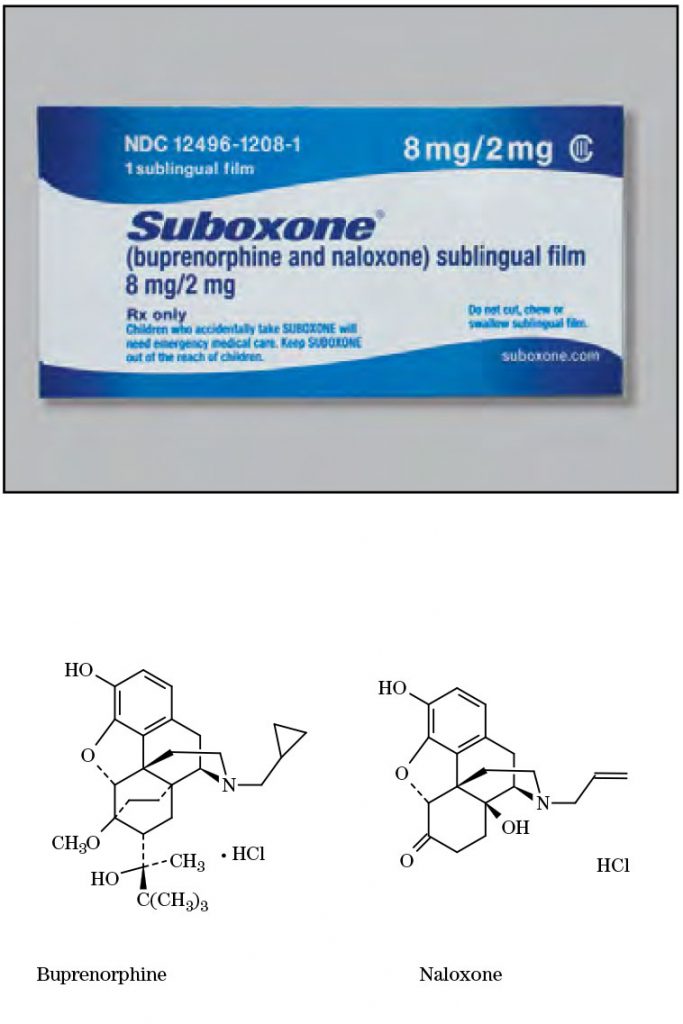
byū’ pri/nōr’ fēn, nal/ox’ ōn
Brand Names: Suboxone®
- Generic Available
Common Dosage Forms:
- Tablets, sublingual*:
2 mg buprenorphine HCl with 0.5 mg naloxone HCl
8 mg buprenorphine HCl with 2 mg naloxone HCl - Film, sublingual:
2 mg buprenorphine HCl with 0.5 mg naloxone HCl
4 mg buprenorphine HCl with 1 mg naloxone HCl
8 mg buprenorphine HCl with 2 mg naloxone HCl
12 mg buprenorphine HCl with 3 mg naloxone HCl
*Subutex is a formulation of buprenorphine sublingual without naloxone.
FDA Indications/Dosages:
- For the treatment of opioid dependence: The recommended target dose is a single daily sublingual dose of 16 mg. Doses as low as 4 mg or as high as 24 mg have been effective. It is advisable to reach induction with Subutex® over the first few days because of the absence of naloxone in this tablet formulation. Induction to an adequate maintenance dose should be reached as soon as possible to prevent opioid withdrawal symptoms.
Under the Drug Addiction Treatment Act (DATA) codified at 21 U.S.C. 823(g), prescription use of this product in the treatment of opioid dependence is limited to physicians who meet certain qualifying requirements, and who have notified the Secretary of Health and Human Services (HHS) of their intent to prescribe this product for the treatment of opioid dependence and have been assigned a unique identification number that must be included on every prescription.
Pharmacology/Pharmacokinetics:
Buprenorphine is a partial opioid agonist/antagonist. It is a partial agonist at the mu-opioid receptor and an antagonist at the kappa-opioid receptor. Naloxone is an antagonist at the mu-opioid receptor. Buprenorphine produces opioid agonist effects similar to methadone and hydromorphone but with a ceiling effect. Low dose naloxone has no significant effect when given orally. When given intravenously, naloxone produces opioid antagonist effects and can precipitate opioid withdrawal. Metabolism occurs via the cytochrome P-450 3A4 isozyme. From plasma, buprenorphine has a mean elimination half-life of 37 hours and naloxone of 1.1 hours.
Drug Interactions:
CYP 3A4 inhibitors (ketoconazole, erythromycin, ritonavir, indinavir, saquinavir) may increase plasma levels. CYP 3A4 inducers (phenobarbital, carbamazepine, phenytoin, rifampicin) may decrease plasma levels. Benzodiazepines and buprenorphine given concomitantly intravenously have resulted in coma and death.
Contraindications/Precautions:
Contraindicated in patients with a known hypersensitivity to any ingredient. Use with caution in patients with compromised respiratory function (COPD, cor pulmonale, hypoxia, or pre-existing respiratory depression. Intravenously misused buprenorphine has resulted in death from respiratory depression. Use with other CNS depressants will cause increased CNS depression. Use with caution in patients with decreased hepatic function; increased intracranial pressure; myxedema or hypothyroidism; adrenal cortical insufficiency (e.g., Addison’s Disease); toxic psychoses; prostatic hypertrophy or urethral stricture; acute alcoholism; delirium tremens; or kyphoscoliosis. Do not use in nursing mothers. Pregnancy Category C.
Adverse Effects:
The most common adverse effects include headache, constipation, nausea, and sweating. Report to a doctor if dizziness, confusion, jaundice (yellow skin or eyes), or shortness of breath occur.
Patient Consultation:
- May cause drowsiness, use caution while operating machinery or when mental alertness is required.
- Abruptly stopping therapy may precipitate withdrawal symptoms.
- Allow the tablet to dissolve under your tongue. Do not chew or swallow the tablets.
- Avoid alcohol and other CNS depressants while taking this medication.
- WARNING: This medication may be habit-forming.
- Store in a cool, dry place away from sunlight and children.
- Contact a physician if the above side effects are severe or persistent.
- If a dose is missed, take it as soon as possible. If it is close to your next dose, skip the missed dose.
- In an emergency, notify emergency room staff that you are dependent on opioids and are being treated with Suboxone.